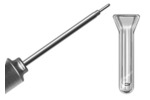- ▶
- Heaters/Source
- ▶
- Agilent Heaters and SensorsMass Spectrometry, Scientific Supplies & ManufacturingScientific Instrument Services 5973 Source Heater Tamper Resistant Allen Wrench 5973/5975 Quad Sensor 5985 Source Heater Assembly Agilent Interface Heater Assembly 5971 Interface Heater

- ▶
- Reference Material on InstrumentationArticle - A High Temperature Direct Probe for a Mass Spectrometer Design of a Direct Exposure Probe and Controller for use ona Hewlett-Packard 5989 Mass Spectrometer SIS AP1000 AutoProbe™ SIS AP2000 AutoProbe™ - Description of System HPP7: Direct Probe Electronics Console HPP7: Direct Probe for the Agilent (HP) 5973/5975 MSD HPP7: HP Direct Probe Application Notes HPP7: Installation Directions for the Direct Probe HPP7: Side Cover for the HP 5973 MSD HPP7: Support HPP7: Probe Inlet System for the Agilent (HP) 5973 and 5975 MSD with Automatic Indexed Stops HPP7: Theory of Operation of the Direct Probe and Probe Inlet System Direct Thermal Extraction Thermal Desorption Application Notes Environmental Thermal Desorption Application Notes Food Science Thermal Desorption Application Notes Forensic Thermal Desorption Application Notes GC Cryo-Trap Application Notes Headspace Application Notes Purge & Trap Thermal Desorption Application Notes Theory of Operation of the AutoDesorb® System AutoDesorb Notes for SIS Dealers Adsorbent Resin Application Notes Installation of the Short Path Thermal Desorption System on Agilent (HP) and Other GCs Installation of the Short Path Thermal Desorption System on a Varian 3400 GC AutoDesorb® System Development Team Thermal Desorption Applications and Reference Materials Installation of the Short Path Thermal Desorption System - TD5 Part I - Design & Operation of the Short Path ThermalDesorption System Installation Instructions for the Model 951 GC Cryo-Trap on the HP 5890 Series GC Installation Instructions for the Model 961 GC Cryo-Trap on the HP 5890 Series GC Operation of the Model 951/961 GC Cryo-Trap SIS GC Cryo Traps - Theory of Operation NIST/EPA/NIH Mass Spectral Enhancements - 1998 version (NIST98) SIMION 3D Ion Optics Class Mass Spectrometer Source Cleaning Methods MS Tip: Mass Spectrometer Source Cleaning Procedures Mass Spec Source Cleaning Procedures Micro-Mesh® Abrasive Sheets Research Papers Using New Era Syringe Pump Systems EI Positive Ion Spectra for Perfluorokerosene (PFK) Cap Liner Information How do I convert between fluid oz and milliliters? Which bottle material should I choose? Which bottle mouth should I choose? The Bottle Selection Guide CGA Connections for Gas Tanks Chemical Reaction Interface Mass Spectrometry (CRIMS)

- Probes
- LiteratureApplication Notes Adsorbent Resins Guide Mass Spec Tips SDS Sheets FAQ MS Calibration Compound Spectra Manuals MS Links/Labs/ Organizations MS Online Tools Flyers on Products/Services Scientific Supplies Catalog About Us NextAdvance Bullet Blender® Homogenizer Protocols Micro-Mesh® Literature Instrumentation Literature Agilent GC/MS Literature SIS News / E-Mail Newsletter NIST MS Database - Update Notifications

- ▶
- HPP7: Installation Directions for the Direct Probe (This Page)
A. Preparation of the MSD for Installation
The SIS Direct Insertion Probe, Model HPP7, is designed to be mounted onto the GC/MS Interface port on the Agilent (HP) 5973/5975 MSD. Before you can install the Probe Inlet system onto the Agilent 5973/5975 MSD, the GC and GC/MS interface must be disconnected from the MSD..
The following procedures are described in detail in the Hewlett Packard 5973 Mass Selective Detector Manual, HP# G1099-90001, Copyright 1996.
1. Vent the MSD (see HP 5973 Manual Chapter 2).
2. Separate the MSD from the GC (see HP 5973 Manual Chapter 4). Be sure that the source and interface temperatures are cooled to below 50 degrees C before proceeding.
3. Remove the cover from the GC/MSD Interface Assembly (see HP 5973 Manual Chapter 4).
4. Remove the three screws holding the GC/MS Interface to the vacuum manifold. Store all removed parts in a safe location for future reinstallation. The probe inlet assembly will be mounted to these same bolt holes using new bolts supplied with the probe inlet system.
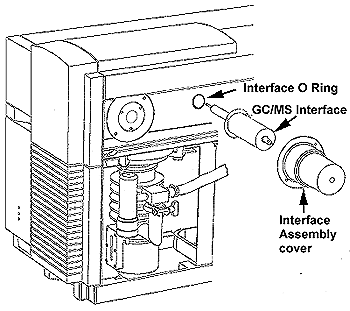
5. Remove the sealing 'O' Ring from the vacuum manifold flange where the GC/MSD interface was removed. Do not discard. This 'O' Ring can be reused for the installation of the probe inlet system.
6. Open the MSD vacuum manifold to allow entrance to the MSD source (see HP 5973 Manual)
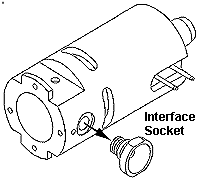
7. Remove the interface socket from the MSD source using the supplied tool. It should not be necessary to remove the source. Store the removed interface socket with the GC/MS interface.
B. Installation of the Probe Interface Socket
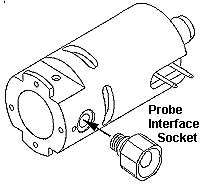
1. Install the new probe interface socket by screwing into the 5973 source in place of the old interface socket. Note that the new probe interface socket is longer and has 4 flat sides. This socket is needed in order to accurately guide the probe to mate with the MSD source.
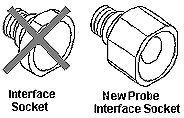
The Interface Socket must be replaced with the new probe socket to avoid breakage of sample vials in the MSD. Glass chips may damage the pumping system.
2. Check to see that the 'O' Ring is still in place. If not then reinstall it making sure that it is clean.
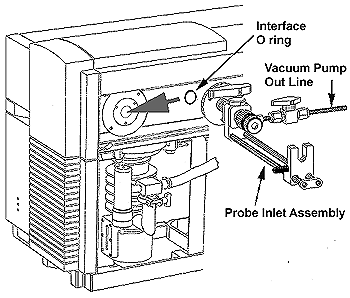
3. Using the three (3) bolts supplied (1/4" x 0.5" long) and Allen wrench attach the probe inlet to the MSD vacuum manifold. Note the correct orientation of the probe inlet system. The probe guide rods should be facing down and the vacuum pump out line should be facing towards the rear of the MSD. Evenly tighten the three bolts to securely fasten the probe inlet system to the vacuum manifold flange.
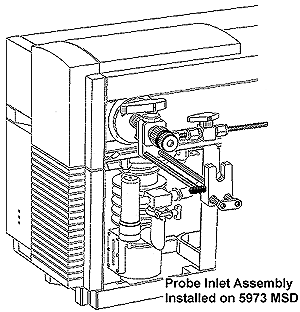
4. Close the MSD vacuum manifold plate in order to seal the MSD source.
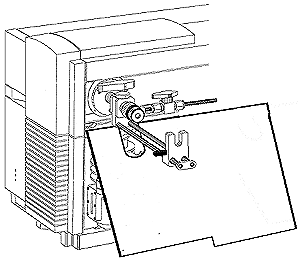
5. Attach the new MSD side panel to the 5973 MSD. This panel should be slid in place by angling it 45 degrees with the U slot just under the stem of the probe inlet system and then slowly slide it into place.
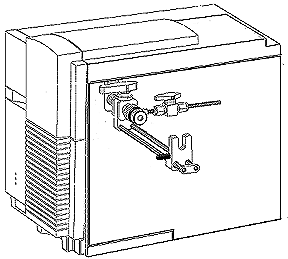
C. Installation of the Vacuum Pump
The direct probe inlet system requires an auxiliary vacuum pump in order to provide an initial roughing out of the probe inlet system before the probe is introduced into the vacuum system of the MSD. This minimizes the introduction of air into the system. An Edwards 1.5 Vacuum pump is used for this purpose. This pump is the same size as used to pump the MSD vacuum system. The probe vacuum roughing pump can either be located behind the probe inlet system on the bench or alternately can be place on the floor or at some other location close to the MSD. The following steps are required in order to set up the roughing vacuum pump.
Two separate vacuum pumps are required. One for the MSD and one for the Probe. Do NOT try to use only one pump.
1. Prepare the vacuum pump according to the manufacturers directions. This includes removing all shipping plugs and charging the vacuum pump with fresh pump oil. (See the HP Manual)
The Vacuum Pump is shipped without Oil. Be sure to charge the pump with new oil before proceeding.
2. Depending on the location of the vacuum pump cut a piece of the ¼" I.D. Tygon vacuum tubing to the required length.
3. Attach one side of the vacuum hose to the ¼" diameter tube on the vacuum pump nipple . Use one of the vacuum hose clamps to securely fasten the hose.
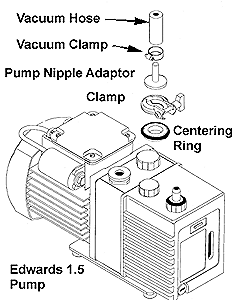
4. Clamp this vacuum pump fitting to the NW25 inlet flange on the Edwards roughing pump using the centering ring with 'O' Ring and clamp supplied with the system.
Vacuum pump exhaust must be properly filtered or exhausted. Refer to vacuum pump manufacturers manual.
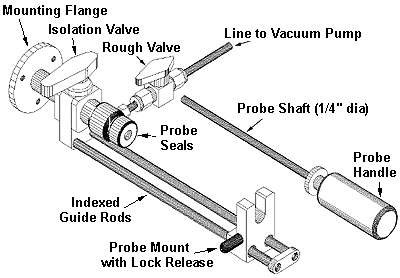
5. Attach the other end of the vacuum hose to the ¼" stem of the tube extending out the back of the probe inlet assembly and again clamp in place with a vacuum hose clamp.
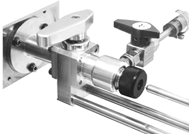
6. Close both valves on the probe inlet system and plug in the vacuum pump to test the pump and check for vacuum leaks.
7. Unplug the vacuum pump.
Installation of the MSD Probe Electronics Console
The probe electronics console is the interface between the PC computer and the direct probe. The PC computer will download the temperature parameters as well as control parameters to the probe electronics console. The probe electronics console will then control the operation of the direct probe heating and cooling through its own microprocessor. The following steps will interface the probe electronics console to the PC and the direct probe.
1. A supply of clean and dry compressed air is required for the cooling of the probe. House compressed air or tank compressed air can be used for this purpose. A moisture trap is recommended in order to minimize the water if the air source is wet. Using the length of 1/8" nylon tubing supplied connect the air source to the rear of the probe electronics onto the quick disconnect fitting marked Air In. The air pressure should be set for 40 to 60 psi for use with the direct probe. Less than 40 psi may result in longer cooling times.
Do not exceed 60 psi air pressure for the safe operation of the probe.
2. Turn off the air supply and check for air leaks.
3. Install the RS232 Cable between the probe electronics console and the PC. The RS232 cable should be attached to an RS232 (serial) port on the PC. Note which port (COM1, COM2, etc.) that the serial cable is attached to on the PC. This port identity will be required during software installation. A 9 pin to 25 pin adapter is provided if required for your particular computer. The opposite end of this cable attaches to the rear of the probe electronics console at the RS232 socket.
Be sure that there is no power supplied to the electronics control during installation of the air and computer connections.
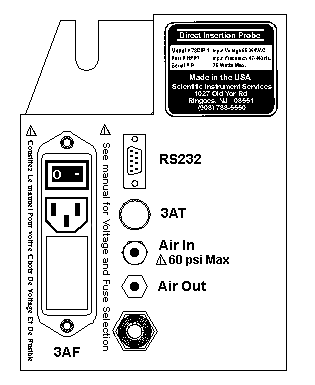
4. Finish the installation of the probe electronics console by making sure all fittings and plugs are secure. Position the probe electronics console under the probe inlet system on the right side of the MSD.
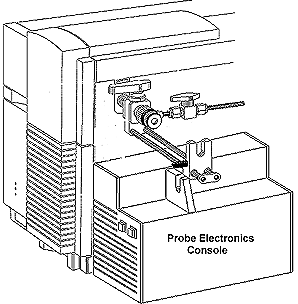
5. The system is normally shipped set for 110 volt output unless requested otherwise. If requested the system can be provided for 220 volt output.
Units shipped with North American power cords have been set for 120 VAC. Check Voltage selection before proceeding. For other voltage selection see Appendex A.
Plug the electronics console into the wall outlet (Switch is OFF).
6. To check status of the controller, turn on the power switch. Both front buttons should illuminate and the controller should beep approximately once every 5 seconds until the software connection is made.
Finish Installation of the Direct Probe
The system is now ready for the attachment of the direct probe to the probe inlet system.
1. Remove the probe from the holder on the probe electronics console and attach to the probe inlet system by sliding into the U shaped bracket on the probe inlet system. Make sure that the sliding probe bracket is fully extended to the right before attaching the probe. It may be necessary to push up on the lock release on the probe bracket to position the probe bracket.
The Mass Spec Vacuum system must be turned OFF and the probe Vacuum Pump must be Unplugged before proceeding. All vacuum systems must be OFF.
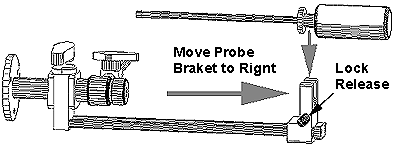
2. Open the isolation valve on the probe inlet system.

4. Gently slide the probe through the probe inlet system and seals until it touches the MSD source. It will be necessary to pull up on the locking release on the probe guide bar to push the probe pass the automatic stops. These stops are provided to allow accurate positioning of the probe during insertion and removal to avoid damage of the probe or probe sample vial as well as to minimize the inadvertent venting of the MSD during probe removal.

5. The probe should slide smoothly through the inlet system. If too loose or tight either loosen or tighten the black probe inlet nut on the end of the probe inlet system. This probe inlet nut will adjust the sealing properties of the probe seals inside the probe inlet system. With extended use this inlet system nut can be adjusted to allow for seal wear or small vacuum leaks.
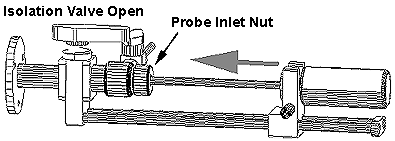
6. The probe should not hang up at the MSD source. It should slide smoothly and seat against the probe interface socket on the MSD source. If it does not seat smoothly, it will be necessary to open the MSD source housing and determine the problem.
Never insert a bent or damaged probe rod into the mass spec via the probe inlet system. This could damage the probe inlet system or mass spec source.
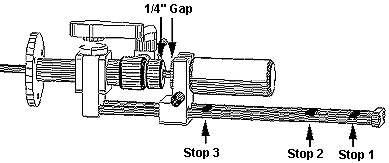
7. The distance between the probe handle and the probe inlet nut should be about ¼" to assure proper location of the probe against the MSD source. This final position is past all 3 stops on the indexed probe guide.


